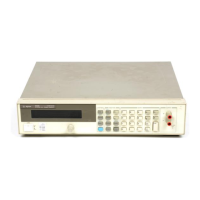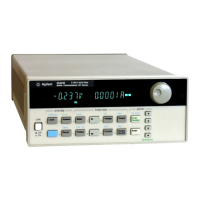9
Fault Indicator (FLT) Circuit Testing
Using Method 1:
a. Connect the LED, resistor, and external 5V power supply to pins 1 and 2 of J702 as shown in Figure 6a,
and turn on the 662x power supply. The LED should be off.
b. Unmask the CV bit (bit 1) in the fault register by sending ’’UNMASK <ch>,1’’.
c. Check to see that the front panel display indicates the supply is in CV mode.
d. The LED should be on.
e. Reset the 662x supply by sending ’’CLR".
f. The LED should be off.
g. Turn off the 662x supply. This concludes testing of the FLT circuit.
Figure 6a. FLT Test Setup
Using Method 2:
a. Connect an ohmmeter* to pins 1 and 2 of J702 and turn on the 662x supply. The ohmmeter should indicate
a high** resistance.
b. Unmask the CV bit (bit 1) in the fault register by sending "UNMASK < ch > ,1".
c. Check to see that the front panel display indicates the supply is in the CV mode.
d. The ohmmeter should now indicate a low** resistance.
e. Reset the 662x supply by sending a ’’CLR’’.
f. The ohmmeter should now indicate a high** resistance.
g. Turn off the 662x supply. This concludes testing of the FLT circuit
* Note the polarity of your DMM’s ohmmeter output. Using an Agilent 3456A in two-wire, auto-range, the
polarity of the internal voltage is reversed (current flows from the - jack to the + jack) so the + jack of the
ohmmeter must be connected to the - pin of the FLT/INH circuit, or to the ground pin of the relay (RLY) circuit
under test. Using an Agilent 3478A the polarity of the ohmmeter is as shown on the front panel of the meter
(current flows from the + jack to the - jack).
** Depending on range and model number, low is generally less than 2K ohms and high is an open (overload).

